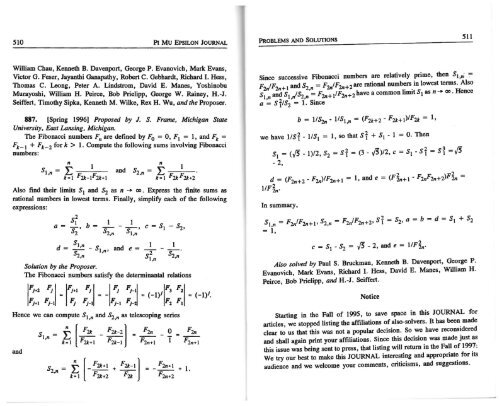Vol. 10 No 6 - Pi Mu Epsilon
Vol. 10 No 6 - Pi Mu Epsilon
Vol. 10 No 6 - Pi Mu Epsilon
- No tags were found...
Create successful ePaper yourself
Turn your PDF publications into a flip-book with our unique Google optimized e-Paper software.
5<strong>10</strong> PI MU EPSILON JOURNAL<br />
PROBLEMS AND SOLUTIONS<br />
511<br />
William Chau, Kenneth B. Davenport, George P. Evanovich, Mark Evans,<br />
Victor G. Feser, Jayanthi Ganapathy, Robert C. Gebhardt, Richard I. Hess,<br />
Thomas C. Leong, Peter A. Lindstrom, David E. Manes, Yoshinobu<br />
<strong>Mu</strong>rayoshi, William H. Peirce, Bob Prielipp, George W. Rainey, H.-J.<br />
Seiffert, Timothy Sipka, Kenneth M. Wilke, Rex H. Wu, and the Proposer.<br />
887. [Spring 1996] Proposed by J. S. Frame, Michigan State<br />
University, East Lansing, Michigan.<br />
The Fibonacci numbers Fn are defined by F 0 = 0, F 1 = 1, and F 1 =<br />
F 1 _ 1 + F 1 _ 2 fork > 1. Compute the following sums involving Fibonacci<br />
numbers:<br />
Also find their limits S 1 and S 2 as n -+ oo. Express the finite sums as<br />
rational numbers in lowest terms. Finally, simplify each of the following<br />
expressions:<br />
s2<br />
a= 1 b= 1<br />
s2, s2,n<br />
d = s 1·" - s1,n• and e = +<br />
s2,n s 1,n<br />
Solution by the Proposer.<br />
1<br />
s2,n.<br />
The Fibonacci numbers satisfy the determinantal relations<br />
fj+2 F 1 fj+1 F 1 fj fj_j F3 F2<br />
= = - = (-1)' = (-1)'.<br />
F 1 +1 fj_ 1 fj ~-t ~-t ~- F 2 F 1<br />
Hence we can compute S 1 ,n and s 2 ,n as telescoping series<br />
and<br />
S1 = t [ F2k - F2k-2] = F2n - 0 =<br />
,n k=1 F2k+1 F2k-1 F2n+1 T F2n+1<br />
s2 = ,n<br />
F2n+1<br />
-- + 1.<br />
F2n+2<br />
Since successive Fibonacci numbers are relatively prime, then S1,n· =<br />
F IF<br />
1 and s = F2niF2n+<br />
2<br />
2 are rational numbers in lowest terms. Also<br />
2n 2n+ ,n • • H<br />
s and 1<br />
s /S = F2n+ 1 2 1<br />
/F2n+ 2 have a common hmttS1 as n- oo. ence<br />
,n ,n ,n .<br />
2<br />
a = S 1 ts 2 = 1. Smce<br />
b = 1/S2n- l!S 1 ,n = (F 21 + 2 - F2k+ 1)/F2k = 1,<br />
we have 1/Sy- 11S 1 = 1, so that Sy + S1 - 1 = 0. Then<br />
s 1<br />
=t2, c = S1 - sr = si =IS<br />
- 2,<br />
d = (F2n+ 2 - F2n)IF2n+ 1 = 1, and e = (F~+1- F2nF2n+2)F~ =<br />
IIF~.<br />
In summary,<br />
c = s.- s2 = IS - 2, and e = IIF~.<br />
Also solved by Paul S. Bruckman, Kenneth B. Davenport, George P.<br />
Evanovich, Mark Evans, Richard I. Hess, David E. Manes, William H.<br />
Peirce, Bob Prielipp, and H.-J. Seiffert.<br />
<strong>No</strong>tice<br />
Starting in the Fall of 1995, to save space in this JOURNAL for<br />
articles, we stopped listing the affiliations of also-solvers. It bas been. made<br />
clear to us that this was not a popular decision. So we have reconstdered<br />
and shall again print your affiliations. Since this decision was made just as<br />
this issue was being sent to press, that listing will return in the Fall of 1997~<br />
We try our best to make this JOURNAL interesting and appropriate for its<br />
audience and we welcome your comments, criticisms, and suggestions.
















